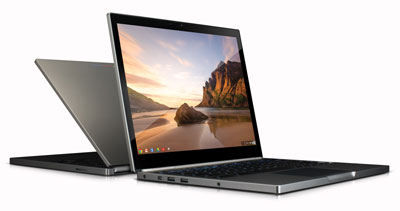News
Google Takes Notes from Apple with Pixel Chromebook
A new high-end Chromebook delivers LTE, touch and an extremely rich display.
- By Scott Bekker
- April 02, 2013
In the Harry Potter universe, wizards avoided naming Voldemort for fear of empowering him. Google Inc. takes the opposite tack, naming products by the technical attribute it hopes the product will utterly eliminate from all conscious awareness.
Thus the explanation of the name "Google Chromebook Pixel" in a blog by Linus Upson announcing the laptop in late February.
"The philosophy of Chrome has always been to minimize the 'chrome' of the browser. In much the same way, the goal of the Pixel is to make the pixels disappear, giving people the best Web experience," wrote Upson, vice president of engineering at Google.
Pixel is at heart a Chromebook, which is Google's take on the laptop. The idea behind the Chromebook was to provide a device for the current reality of near-always-on connection with the Internet. It relies on storing documents, inboxes and other files in the cloud (specifically Google's cloud).
Pixel departs from the original Chromebook pattern in a few ways.
Industrial Design
The most notable way is in its industrial design. Previous Chromebooks were somewhat clunky. The Google Web site for Pixel takes a page from the Apple Inc. book on the dark arts of seduction. Similarly, the laptop itself is reminiscent of Apple's fine-looking devices. Upson's blog calls out key design points: anodized aluminum alloy, hidden vents, invisible screws, speakers hidden behind a backlit keyboard and a glass touchpad. The overall effect is a slick device, and that's before taking the display into account.
 Figure 1. Sleeker than previous Chromebooks and featuring a more impressive display, Google's new Pixel laptop borrows from Apple's design aesthetic and high-end pricing.
Figure 1. Sleeker than previous Chromebooks and featuring a more impressive display, Google's new Pixel laptop borrows from Apple's design aesthetic and high-end pricing.
The most striking part of the industrial design is the 12.85-inch screen when it's powered on. The pixel density of 239 pixels per inch provides a total of 4.3 million pixels. Google claims that's the highest density of pixels per inch of any laptop screen on the market.
There's also a 720p webcam and a three-microphone array for maximum pickup and background noise cancellation. While the device has minimal onboard storage, the purchase includes 1TB of free online storage for three years.
Touch
Microsoft is no longer alone in pushing touch for laptops. Apple may still contend that touch is for tablets and smartphones, but Google is putting a touchscreen on Pixel and building touch capability into the Chrome OS, complete with tapping, pinch-zooming and swiping.
Connectivity
Rock-solid Wi-Fi reception is critical for a Web-first device, and Pixel boasts dual-band support and specially placed antennas for maximum range. But Pixel will take connectivity a few steps further.
The big step is a version that supports the Verizon Wireless 4G network, called LTE, allowing for fast data connections almost anywhere in the United States. The other is the inclusion of a dozen Gogo Inflight Internet passes for using Pixel on an airplane. Airlines currently using Gogo include Air Canada, AirTran, Alaska Airlines, American Airlines, Delta, Frontier, United, US Airways and Virgin America.
A New Price Category
Part of the reason Chromebooks looked clunky was because they were designed to be cheap. Pixel abandons that pricing model and goes all out for the high end. While some Chromebooks are available for $200 to $250, the Wi-Fi Pixel starts at $1,300 from the Google Play store and from Best Buy. That version has been shipping since March.
The version with LTE costs $1,500, not counting the monthly data plan. That version begins shipping in the United States this month.
Google's Own
One other point about design -- this one's made by Google. Previous Chromebooks came from Samsung, Acer Inc., Lenovo and Hewlett-Packard Co. Upson used his blog to thank those partners, and Google is positioning its models as inspiration for future OEM designs. Microsoft tried that tack, too, with the Surface, and the ripples of OEM anger are still visible in the normally smooth pond of Microsoft-OEM public statements.
Google's product is far out of the price range of its partners' products, so backlash may be minimal. Still, it will be interesting to see the effect of Google's move on other manufacturers' commitment to the still-fledgling category of Chromebooks.
About the Author
Scott Bekker is editor in chief of Redmond Channel Partner magazine.